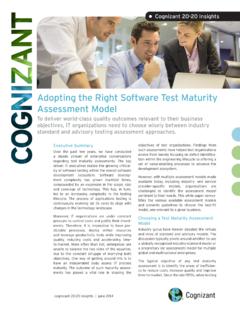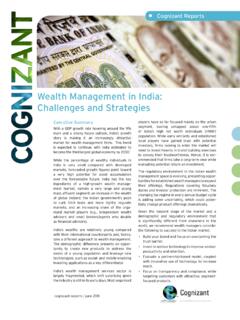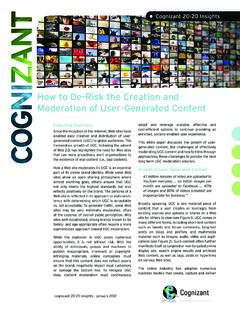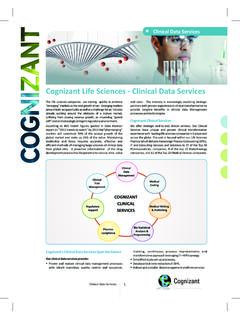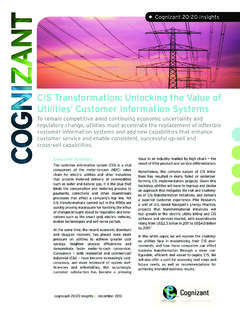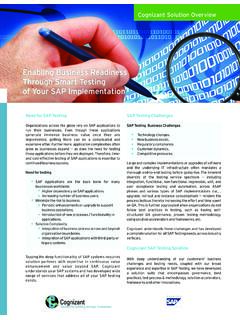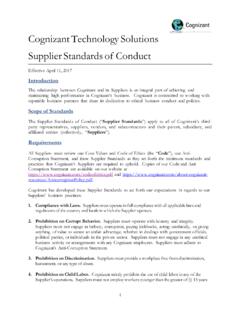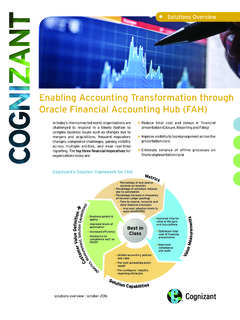Transcription of Making BYOD Work for Your Organization - Cognizant
1 The bring your own device movement compels organizations to strike the right balance between employee freedom and corporate control over technology. Organizations should take a measured approach to transition to BYOD and chart a middle path to reap its benefits to avoid falling behind proactive BYOD work for your Organization | FUTURE OF WORKJune 2012 Making BYOD work FOR your Organization 2 Executive Summary The influx of personal smartphones, tablets and laptops that connect with and use corporate resources is challenging companies to walk a fine line between channeling the benefits of employees purchasing and using their own mobile devices and Making these devices secure and cost- effective enough for the enterprise.
2 Known as BYOD, or bring your own device, this consumer-led movement is transforming enterprise workspaces by extend-ing the notion that 21st century employees need to work from anywhere, at anytime and on their devices of choice, both within and outside of the traditional corporate structure. BYOD is not only disrupting the traditional way technology is provisioned, paid for and used, but it also promises the dual benefits of simultaneously driving down IT costs while improv-ing employee productivity and satisfaction. The BYOD trend holds immense potential to transform business, enable agility and encourage innovative ways of interacting with customers and business partners.
3 The key is to approach BYOD holistically, responding to employee expectations while fulfilling business requirements for security, compliance and risk mitigation. Transitioning to a BYOD model should be phased in over time. Organizations need to mitigate security risks, such as inappropriate usage or loss of corporate data and the ensuing financial and legal implications. Establishing effective governance mechanisms to ensure data privacy and security can be challenging when embracing a BYOD philosophy. In addition, advances in consumer technology and device heterogeneity are creating complexities that can undoubtedly turn into nightmares for IT if not handled properly.
4 3 FUTURE OF work June 2012 Organizations should deconstruct traditional workspaces, using virtualization to decouple dependencies among hard-ware, OS, applications and user states found in traditional desktop configurations. This gives them greater flexibility to stream the right set of user profile, data and applications on-demand, at the right performance level and in a secure manner to any device, based on employee roles and IT the foreseeable future, companies should take a limited BYOD approach (the middle path), with finite lists of supported devices that are easier and less costly to manage. A limited-BYOD infrastructure that is platform and OS-agnostic will help minimize security breaches and the organizational resources needed to support and manage employee-owned devices.
5 Deploying the right combination of mobile device management (MDM), mobile application management (MAM) and mobile application development platform (MADP) solutions can help organizations secure and quickly update business apps on employee devices and perform compliance reporting, all while providing employees the flexibil-ity they demand, resulting in improved productivity and higher previous waves of technology change, BYOD promises to pervade all parts of the business. Proactive organiza-tions that embrace this trend and mold it in suitable ways to benefit the business will gain the critical lead to out-perform the 2012 Making BYOD work FOR your Organization 4 BYOD BeginningsThe proliferation of affordable computing devices and technology in the 1980s and 90s had organizations scurrying to adjust to the trend of employees using non-corporate devices for work .
6 Being off the IT radar, portable computers and first-generation handheld devices confounded many organizations that recognized their utility but could not fully embrace them because of the command and control issues they raised. Today, with even greater advances in consumer technology, mobile applications and the affordability of smart and powerful mobile devices, organizations are more challenged than ever to incorporate them into the enterprise IT architecture. IT departments are understandably concerned about the security and data privacy risks that accompany the BYOD movement, as well as the increased support costs. But the genie is out of the bottle. BYOD holds the promise of not only enabling companies to become more agile and customer-focused, but also helping employees rapidly create and apply knowledge at work , which is key to deriv-ing competitive advantage in a knowledge-driven economy.
7 The issue today is for enterprises to embrace these changes in ways that improve organiza-tional effectiveness and productivity while mitigating risk. Organizations need to be proactive in avoiding the mistakes of the past so they can benefit from the cost and productivity advantages of BYOD initiatives, as well as the ability to meet employee expectations and enable anytime/anywhere Consumerization and BYOD Consumerization of IT is transforming the traditional IT landscape of organizations and the way employees use technology. The traditional lines between work and personal life continue to blur for employees. Seeking flexibility and choice in how they work , more and more employees are using their personal (smart) devices in the workplace.
8 An IDC survey found that in 2011, 40% of devices used by informa-tion workers to access business applications were personal devices, compared with 30% in 20101 (see Figure 1), a 33% increase in just one year. According to the survey, 30% of information workers used their PCs, and 10% used their tablets for Devices Used to Access Business PC, PC,smartphone20102011 Personally-ownedCompany-ownedBase for 2010: 2,820 responses from enterprises with 500 or more employees from 10 for 2011: Over 3,000 information workers andbusiness executives from nine : IDC Information Worker Custom Survey, May 2011 and May PC,smartphone, PC,smartphone,tablet5 FUTURE OF work June 2012 work -related tasks.
9 BYOD demand and adoption varies by industry, with financial services, insurance, healthcare and professional services leading the way (see Figure 2).2As businesses realize that they can no longer dictate what devices should be used at work , many are looking for ways to approach BYOD to advance their strategic agenda. Benefits for Employees and OrganizationsA major driver of BYOD is the productivity advantage resulting from improved employee satisfaction and worker mobility, as well as lower costs of technology adoption and refresh (see Figure 3, next page). Other benefits include: Increased productivity and employee satisfaction.
10 BYOD provides the flexibility that employees seek to respond instantly to work requests outside of work hours, thus reducing process times and improving operational efficiency. In addition, employees report higher satisfaction levels with such flexible work arrangements and the freedom to use their devices of choice. Attracting, retaining and supporting new talent. Expected to soon become the largest segment of the workforce, many millennials openly seek environ-ments that allow them the freedom to use tools and technologies native to their upbringing and customized to their work and life preferences (see Figure 4, page 7). Lower IT procurement, support costs.
